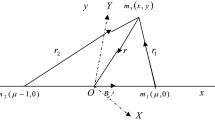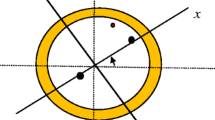Abstract
This paper investigates the motion of an infinitesimal body in the generalized restricted three-body problem. It is generalized in the sense that both primaries are radiating, oblate bodies, together with the effect of gravitational potential from a belt. It derives equations of the motion, locates positions of the equilibrium points and examines their linear stability. It has been found that, in addition to the usual five equilibrium points, there appear two new collinear points L n1, L n2 due to the potential from the belt, and in the presence of all these perturbations, the equilibrium points L 1, L 3 come nearer to the primaries; while L 2, L 4, L 5, L n1 move towards the less massive primary and L n2 moves away from it. The collinear equilibrium points remain unstable, while the triangular points are stable for 0<μ<μ c and unstable for \(\mu_{c} \le\mu\le\frac{1}{2}\), where μ c is the critical mass ratio influenced by the oblateness and radiation of the primaries and potential from the belt, all of which have destabilizing tendency. A practical application of this model could be the study of the motion of a dust particle near the oblate, radiating binary stars systems surrounded by a belt.





Similar content being viewed by others
References
Abdul Raheem, A., Singh, J.: Astron. J. 131, 1880 (2006)
Collins, G.W.: Celest. Mech. 119 (2004)
Das, M.K., Narang, P., Mahajan, S., Yuasa, M.: Astrophys. Space Sci. 314, 261 (2008)
Greaves, J.S., Holland, W.S., Moriarty-Schieven, G., Jenness, T., Dent, W.R.F., Zuckerman, B., Mccarthy, C., Webb, R.A., Butner, H.M., Gear, W.K., Walker, H.J.: Astrophys. J. 506, 133 (1998)
Ishwar, B., Elipe, A.: Astrophys. Space Sci. 277, 67 (2001)
Jiang, I.G., Yeh, L.C.: Int. J. Bifurc. Chaos 13, 534 (2003)
Jiang, I.G., Yeh, L.C.: Astrophys. Space Sci. 305, 341–348 (2006)
Kushvah, B.S.: Astrophys. Space Sci. 318, 41 (2008)
Luk’yanov, L.G.: Sov. Astron. 33, 92 (1989)
Miyamoto, M., Nagai, R.: Publ. Astron. Soc. Jpn. 27, 533 (1975)
Poynting, J.H.: Philos. Trans. R. Soc. Lond. 202, 525 (1903)
Radzievskii, V.V.: Astron. J. 27(5), 250 (1950)
Radzievskii, V.V.: Astron. Zh. 30, 225 (1953)
Sharma, R.K.: Astophys. Space Sci. 135, 271 (1987)
Sharma, R.K., Subba Rao, P.V.: Celest. Mech. 12, 189 (1975)
Sharma, R.V., Taqvi, Z.A., Bhatnagar, K.B.: Indian J. Pure Appl. Math. 32(2), 255 (2001a)
Sharma, R.V., Taqvi, Z.A., Bhatnagar, K.B.: Indian J. Pure Appl. Math. 32(7), 981 (2001b)
Simmons, J.F.L., McDonald, J.C., Brown, J.C.: Celest. Mech. 35, 145 (1985)
Singh, J., Ishwar, B.: Bull. Astron. Soc. India 27, 415–424 (1999)
Singh, J.: Astron. J. 137, 3286–3292 (2009)
Singh, J., Begha, J.M.: Astrophys. Space Sci. 331, 511–519 (2011)
Szebehely, V.: Theory of Orbits: The Restricted Problem of Three Bodies. Academic Press, New York (1967)
Trilling, D.E., Stansberry’J, A., Stapelfeldt, K.R., Rieke, G.H., Su, K.Y.L., Gray, R.O., Corbally, C.J., Bryden, G., Chen, C.H., Boden, A., Beichman, C.A.: Astrophys. J. 658, 1289 (2007)
Yeh, L.C., Jiang, I.G.: Astrophys. Space Sci. 306, 189 (2006)
Author information
Authors and Affiliations
Corresponding author
Rights and permissions
About this article
Cite this article
Singh, J., Taura, J.J. Motion in the generalized restricted three-body problem. Astrophys Space Sci 343, 95–106 (2013). https://doi.org/10.1007/s10509-012-1225-0
Received:
Accepted:
Published:
Issue Date:
DOI: https://doi.org/10.1007/s10509-012-1225-0




